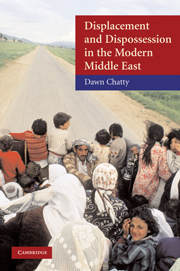Book contents
- Frontmatter
- Contents
- List of Tables
- List of Charts and Maps
- Acknowledgements
- Introduction: Dispossession and Forced Migration in the Middle East: Community Cohesion in Impermanent Landscapes
- 1 Dispossession and Displacement within the Contemporary Middle East: An Overview of Theories and Concepts
- 2 Dispossession and Forced Migration in the Late Ottoman Empire: Distinct Cultures and Separated Communities
- 3 Circassian, Chechnyan, and Other Muslim Communities Expelled from the Caucasus and the Balkans
- 4 The Armenians and Other Christians: Expulsions and Massacres
- 5 Palestinian Dispossession and Exodus
- 6 Kurds: Dispossessed and Made Stateless
- 7 Liminality and Belonging: Social Cohesion in Impermanent Landscapes
- Bibliography
- Index
7 - Liminality and Belonging: Social Cohesion in Impermanent Landscapes
Published online by Cambridge University Press: 05 June 2012
- Frontmatter
- Contents
- List of Tables
- List of Charts and Maps
- Acknowledgements
- Introduction: Dispossession and Forced Migration in the Middle East: Community Cohesion in Impermanent Landscapes
- 1 Dispossession and Displacement within the Contemporary Middle East: An Overview of Theories and Concepts
- 2 Dispossession and Forced Migration in the Late Ottoman Empire: Distinct Cultures and Separated Communities
- 3 Circassian, Chechnyan, and Other Muslim Communities Expelled from the Caucasus and the Balkans
- 4 The Armenians and Other Christians: Expulsions and Massacres
- 5 Palestinian Dispossession and Exodus
- 6 Kurds: Dispossessed and Made Stateless
- 7 Liminality and Belonging: Social Cohesion in Impermanent Landscapes
- Bibliography
- Index
Summary
As the three great empires of Europe and the Middle East fell, the movement of people into and within the Middle East far surpassed that of those fleeing the region. The history of Ottoman tolerance for minorities is part of the explanation of this great inflow. However, the fact that Muslim refugees from the borderlands of the three empires were unwelcome both in Europe and in the new Soviet Union also determined that the first – or perhaps only – choice of movement was south and then west. Four such groups have been the focus of this book: the Muslim Circassians and related peoples; the Armenians and other Eastern Christian peoples; the Palestinians; and the Kurds. They represent a significant range of the ethno-religious communities who were dispossessed, uprooted, and made liminal. Eventually – and largely through their own efforts – these groups reestablished socially cohesive identities in the Arab Middle East assisted perhaps by the cultural memory of the Ottoman millet, which tolerated and encouraged ethno-religious ‘otherness’ and in some ways respected a local ‘cosmopolitanism’.
This book has aimed to contextualize the experience of dispossession among these forced migrants within the international and regional political arena of its time. Furthermore, by highlighting the individual experiences of forced migration within the dispossessed populations, it has set out to understand the mechanisms whereby individuals and family members have created new communities, often without contiguous territorial bases.
- Type
- Chapter
- Information
- Displacement and Dispossession in the Modern Middle East , pp. 279 - 304Publisher: Cambridge University PressPrint publication year: 2010



